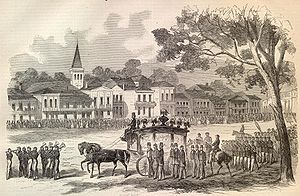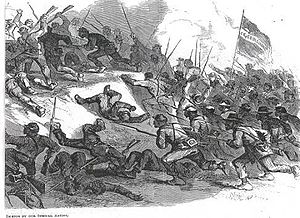
Andre Cailloux
Encyclopedia

Union Army
The Union Army was the land force that fought for the Union during the American Civil War. It was also known as the Federal Army, the U.S. Army, the Northern Army and the National Army...
to be killed in combat during the American Civil War
American Civil War
The American Civil War was a civil war fought in the United States of America. In response to the election of Abraham Lincoln as President of the United States, 11 southern slave states declared their secession from the United States and formed the Confederate States of America ; the other 25...
. He died heroically during the unsuccessful first attack on the Confederate
Confederate States Army
The Confederate States Army was the army of the Confederate States of America while the Confederacy existed during the American Civil War. On February 8, 1861, delegates from the seven Deep South states which had already declared their secession from the United States of America adopted the...
fortifications during the Siege of Port Hudson
Siege of Port Hudson
The Siege of Port Hudson occurred from May 22 to July 9, 1863, when Union Army troops assaulted and then surrounded the Mississippi River town of Port Hudson, Louisiana, during the American Civil War....
, Louisiana
Louisiana
Louisiana is a state located in the southern region of the United States of America. Its capital is Baton Rouge and largest city is New Orleans. Louisiana is the only state in the U.S. with political subdivisions termed parishes, which are local governments equivalent to counties...
. Accounts of his heroism were widely reported in the press, and became a rallying cry for the recruitment of African-Americans into the Union Army.
Early life
Born a slave in Louisiana in 1825, Cailloux lived his entire life in and around New OrleansNew Orleans, Louisiana
New Orleans is a major United States port and the largest city and metropolitan area in the state of Louisiana. The New Orleans metropolitan area has a population of 1,235,650 as of 2009, the 46th largest in the USA. The New Orleans – Metairie – Bogalusa combined statistical area has a population...
. He was owned by members of the Duvernay family until 1846, when his petition for manumission
Manumission
Manumission is the act of a slave owner freeing his or her slaves. In the United States before the passage of the Thirteenth Amendment to the United States Constitution, which abolished most slavery, this often happened upon the death of the owner, under conditions in his will.-Motivations:The...
, which was supported by his owner, was granted by an all-white police jury in the city of New Orleans. In 1847, Cailloux married Felicie Coulon, whose mother, Feliciana, a mulatto
Mulatto
Mulatto denotes a person with one white parent and one black parent, or more broadly, a person of mixed black and white ancestry. Contemporary usage of the term varies greatly, and the broader sense of the term makes its application rather subjective, as not all people of mixed white and black...
woman, had participated in the local placage
Plaçage
Plaçage was a recognized extralegal system in which white French and Spanish and later Creole men entered into the equivalent of common-law marriages with women of African, Indian and white Creole descent. The term comes from the French placer meaning "to place with"...
system as the common law wife of a white plantation
Plantation
A plantation is a long artificially established forest, farm or estate, where crops are grown for sale, often in distant markets rather than for local on-site consumption...
owner, Valentin Encalada, for several years. Though Felicie was not Encalada’s daughter, she remained his property until her mother bought her freedom from Encalada in 1842. Cailloux and Coulon had four children, three of whom survived to adulthood.
As a young man, Cailloux had learned the cigar making trade as an apprentice. Upon gaining his freedom, he earned his living as a cigar maker, and prior to the beginning of the Civil War, established his own cigar making business. Though his financial circumstances were modest, Cailloux became recognized as a leader within the free African-French Creole community of New Orleans.
An avid sportsman, Cailloux was admired as one of the best boxers in the city. He was also an active supporter of the Institute Catholique
Institute Catholique
The Institute Catholique, also known as the Catholic School for Indigent Orphans or the "Ecole Des Orphelins Indigents" was a school founded in the Fauborg Marigny district of New Orleans in 1840 dedicated to providing a free education to African-American orphans. It was the first school in the...
, a school for orphaned black children, that also taught the children of free people of color. After his manumission, Cailloux learned to read, probably with the assistance of the teachers at the Institute Catholique. He became fluent in both English and French. By 1860, Cailloux was a well-respected member of the 10,000 “free men of color” African-Creole community in New Orleans. At the time, New Orleans was the largest city in the South, and the sixth largest city in the United States, with a population of about 100,000.
Civil War
At the outbreak of the Civil War in 1861, Cailloux became a lieutenantLieutenant
A lieutenant is a junior commissioned officer in many nations' armed forces. Typically, the rank of lieutenant in naval usage, while still a junior officer rank, is senior to the army rank...
in the Native Guard
1st Louisiana Native Guard (CSA)
The 1st Louisiana Native Guard was a Confederate Louisiana militia of "free persons of color" formed in 1861 in New Orleans, Louisiana. It was disbanded in February 1862; some of the members joined the Union Army's 1st Louisiana Native Guard regiment The 1st Louisiana Native Guard (CSA) was a...
, a Confederate regiment
Regiment
A regiment is a major tactical military unit, composed of variable numbers of batteries, squadrons or battalions, commanded by a colonel or lieutenant colonel...
organized to defend the city of New Orleans. This made him one of the first African American officers of any North American unit. The regiment consisted entirely of free men of color who resided in and around New Orleans. Though the regiment was organized primarily as a public relations move by the Confederate Government of the state of Louisiana, and provided no financial support to its members, Cailloux took his responsibilities seriously, and his unit was observed to be well drilled and well trained.
The Confederate Native Guard were never called to active duty, and were disbanded before Union Admiral David Farragut
David Farragut
David Glasgow Farragut was a flag officer of the United States Navy during the American Civil War. He was the first rear admiral, vice admiral, and admiral in the United States Navy. He is remembered in popular culture for his order at the Battle of Mobile Bay, usually paraphrased: "Damn the...
captured the city of New Orleans in April 1862. In September, 1862, Union General Benjamin F. Butler
Benjamin Franklin Butler (politician)
Benjamin Franklin Butler was an American lawyer and politician who represented Massachusetts in the United States House of Representatives and later served as the 33rd Governor of Massachusetts....
, military commander of the Department of the Gulf, who made his headquarters in New Orleans, organized an all-black Union Army 1st Louisiana Native Guard
1st Louisiana Native Guard
The 1st Louisiana Native Guard was one of the first all-black regiments to fight in the Union Army during the American Civil War. It was based in New Orleans, Louisiana, and played a prominent role in the Siege of Port Hudson...
regiment. Andre Cailloux joined this regiment and was made captain of Company E.
Cailloux’s company was considered one of the best drilled in the Native Guard, and Cailloux gradually earned the respect of the white officer who commanded the regiment, Colonel Spencer Stafford. When General Nathaniel P. Banks replaced Butler as Commander of the Department of the Gulf in December 1862, he brought with him an additional 30,000 troops, bringing the total troop strength under his command to 42,000.
By this time, the all-black Native Guard had grown to three regiments. Though the line officers (lieutenants and captains) were black, the commanding officers (colonels, lieutenant colonels, and majors) were white. Banks set out to remove all black officers from their positions, and generally accomplished this with the 2nd and 3rd Regiments, but was unable to do so with the 1st Regiment, to which Andre Cailloux belonged.
The 1st Regiment of the Native Guard was assigned primarily to fatigue duty (chopping wood, digging trenches) until May 1863, when Banks moved most of his army (35,000 men) in a position to surround the Confederate fortifications at Port Hudson, Louisiana
Port Hudson, Louisiana
Port Hudson is a small unincorporated community in East Baton Rouge Parish, Louisiana, United States. Located about northwest of Baton Rouge, it is most famous for an American Civil War battle known as the Siege of Port Hudson.-Geography:...
. Port Hudson was a strategically located fort on a bend in the Mississippi River
Mississippi River
The Mississippi River is the largest river system in North America. Flowing entirely in the United States, this river rises in western Minnesota and meanders slowly southwards for to the Mississippi River Delta at the Gulf of Mexico. With its many tributaries, the Mississippi's watershed drains...
just 20 miles (32.2 km) north of Baton Rouge, Louisiana
Baton Rouge, Louisiana
Baton Rouge is the capital of the U.S. state of Louisiana. It is located in East Baton Rouge Parish and is the second-largest city in the state.Baton Rouge is a major industrial, petrochemical, medical, and research center of the American South...
. At the time, the Confederacy controlled the two-hundred-mile stretch of the Mississippi River between Vicksburg, Mississippi
Vicksburg, Mississippi
Vicksburg is a city in Warren County, Mississippi, United States. It is the only city in Warren County. It is located northwest of New Orleans on the Mississippi and Yazoo rivers, and due west of Jackson, the state capital. In 1900, 14,834 people lived in Vicksburg; in 1910, 20,814; in 1920,...
, in the north and Port Hudson in the south.
While General Ulysses Grant laid siege to Vicksburg, Banks laid siege to Port Hudson.
Death

Minié ball
The Minié ball is a type of muzzle-loading spin-stabilising rifle bullet named after its co-developer, Claude-Étienne Minié, inventor of the Minié rifle...
tore through his arm, which was left dangling uselessly by his side. Severely wounded, Cailloux continued to lead the charge until a Confederate artillery shell killed him.
Despite a truce the next day asked for by Banks, and granted by the Confederate commander Franklin Gardner
Franklin Gardner
Franklin Gardner was a Confederate general in the American Civil War, best noted for his service at the Siege of Port Hudson.-Early life:...
, for the purpose of recovering the Union dead from the field of battle, rebel sharpshooters kept Northern soldiers from collecting black casualties. Cailloux’s decomposing body lay on the ground for 47 days until Port Hudson finally surrendered to Banks on July 9, 1863.
Funeral
Cailloux’s funeral was held in New Orleans on July 29, 1863, and was attended by thousands. His heroism became almost mythical during the Civil War, and was often referred to by leading proponents of African-American soldiers serving in the Union Army.After Cailloux’s death, his widow, Felicie, struggled to receive the financial benefits promised by the United States Government. After several years of effort, she received a small pension. However, she died in poverty in 1874, working at the time as a domestic servant for the Catholic priest who had preached the eulogy at her husband’s funeral.

